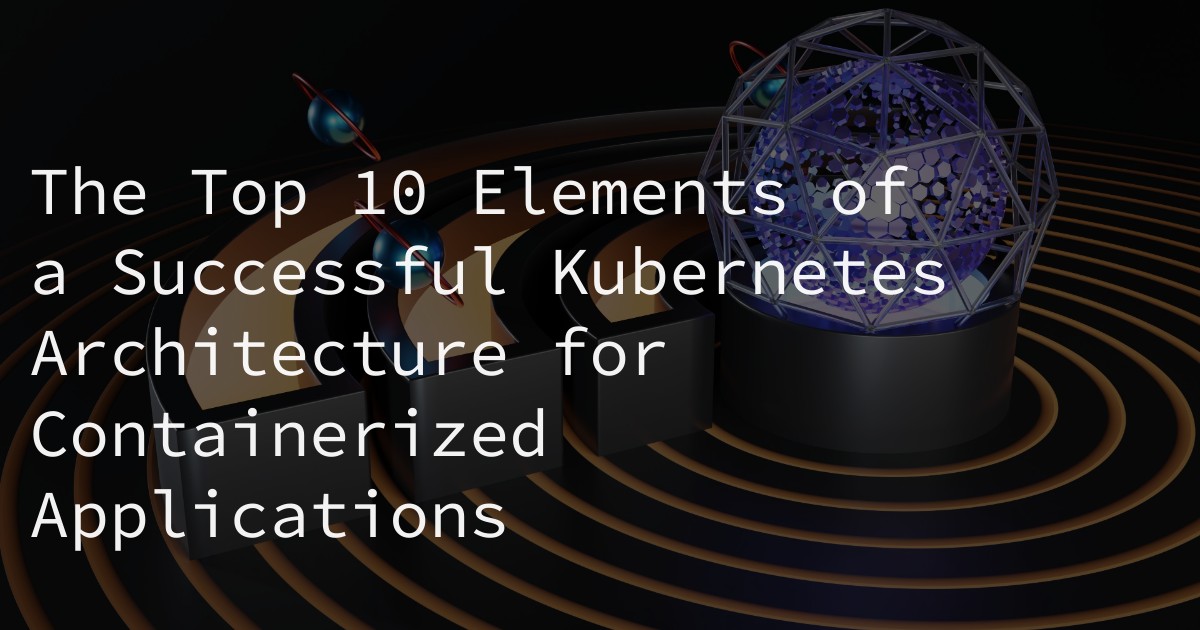
23 Oct The Top 10 Elements of a Successful Kubernetes Architecture for Containerized Applications
Kubernetes has become the go-to platform for managing containerized applications in the cloud. Its ability to automate deployment, scaling, and management of applications has made it an essential tool for cloud computing and cloud-native computing. However, to fully harness the power of Kubernetes, it is crucial to have a well-designed and efficient architecture in place. In this article, we will dive into the top 10 elements of a successful Kubernetes architecture for containerized applications, covering everything from scalability and resilience to best practices and tools for managing Kubernetes infrastructure.
Key Elements of a Successful Kubernetes Architecture
Scalability and Resilience
One of the key benefits of Kubernetes is its ability to scale applications horizontally and vertically. Horizontal scaling involves adding more instances of an application to handle increased workload demands, while vertical scaling involves increasing the resources allocated to an application. Kubernetes also offers features such as replica sets and auto-scaling to manage workload demands automatically. Additionally, Kubernetes ensures high availability and fault tolerance through pod replication and self-healing, making it a reliable platform for running containerized applications.
Design Considerations for Containerized Applications with Kubernetes
When designing containerized applications for Kubernetes, it is essential to follow microservices architecture principles and decouple services. This allows for better scalability, flexibility, and resilience of the application. Kubernetes also enables portability and flexibility through the use of containers, making it easier to move applications between different environments. The use of labels and selectors in Kubernetes allows for efficient management of resources, making it easier to identify and manage specific components of an application.
Infrastructure as Code (IaC)
Infrastructure as Code (IaC) is a methodology for managing and provisioning infrastructure through code. In Kubernetes architecture, IaC allows for the automated deployment and configuration of resources, making it easier to manage and maintain the infrastructure. Tools like Helm and Terraform are commonly used for managing infrastructure as code in Kubernetes environments, providing a more efficient and reliable way to manage resources.
CI/CD Pipelines
Continuous Integration and Continuous Delivery (CI/CD) pipelines are essential for automating the testing, building, and deployment of applications. In Kubernetes architecture, integrating CI/CD pipelines allows for faster and more reliable deployments. Popular tools like Jenkins, GitLab, and Spinnaker can be used to automate the testing and deployment process, ensuring that applications are continuously delivered to production with minimal downtime.
Monitoring, Logging, and Tracing
Monitoring is crucial in Kubernetes architecture for identifying and resolving issues in real-time. Tools like Prometheus, Grafana, and the ELK stack can be used for monitoring, logging, and tracing in Kubernetes environments. Implementing distributed tracing allows for better troubleshooting and performance optimization of applications, making it easier to identify and resolve issues.
Networking
Kubernetes offers different networking models, each with its own pros and cons. It is essential to choose the right networking model based on the specific needs of the application. Additionally, configuring network policies in Kubernetes allows for secure communication between pods and services. The implementation of a service mesh, such as Istio, Linkerd, or Consul, can provide advanced network management and security for microservices communication.
Storage and Data Management
Kubernetes offers various storage options, such as persistent volumes and storage classes, for managing data in containerized applications. It is crucial to choose the right storage option based on the specific needs of the application. Tools like Velero can be used for backup and disaster recovery in Kubernetes environments, ensuring the safety and availability of data.
Service Mesh
A service mesh is a dedicated infrastructure layer for managing service-to-service communication in a microservices architecture. In Kubernetes, a service mesh can provide advanced features such as load balancing, traffic routing, security, and observability for microservices communication. Popular service mesh options include Istio, Linkerd, and Consul.
Security
Security is a critical aspect of Kubernetes architecture. It is crucial to implement security best practices, such as Role-Based Access Control (RBAC) and network policies, to ensure secure access and communication between components of an application. Regular security updates and patches should also be applied to the Kubernetes infrastructure to prevent any potential vulnerabilities.
DevOps, DevSecOps, and FinOps
Kubernetes architecture is closely tied to DevOps principles, promoting collaboration and efficiency in software development and deployment. The integration of security (DevSecOps) and cost optimization (FinOps) into DevOps processes can further enhance the efficiency and effectiveness of Kubernetes infrastructure. Tools and practices for implementing DevOps, DevSecOps, and FinOps in a Kubernetes environment should be carefully considered and implemented.
Best Practices for Kubernetes Infrastructure
- Use of namespaces for logical segregation of resources
- Configuration of resource limits and requests for efficient resource utilization
- Implementation of health checks and readiness probes for better application performance
- Adoption of rolling updates and canary deployments for seamless updates and testing
- Regular maintenance and updates for security patches and bug fixes
- Use of Kubernetes dashboards and monitoring tools for efficient management of resources
- Implementation of disaster recovery and backup plans for business continuity
Conclusion
In conclusion, a successful Kubernetes architecture for containerized applications requires careful planning and implementation of key elements such as scalability, resilience, design considerations, infrastructure as code, CI/CD pipelines, monitoring, networking, storage and data management, service mesh, security, and DevOps, DevSecOps, and FinOps principles. By following best practices and continuously learning and staying updated with the evolving Kubernetes ecosystem, organizations can fully leverage the power of Kubernetes for their containerized applications.



Sorry, the comment form is closed at this time.